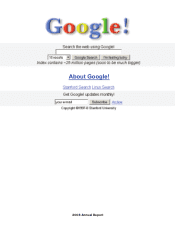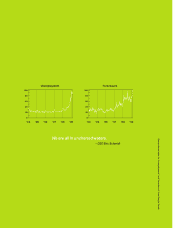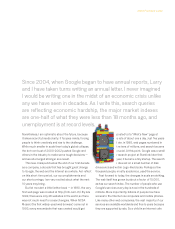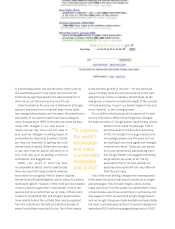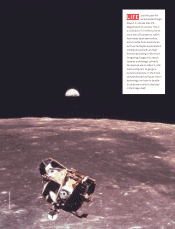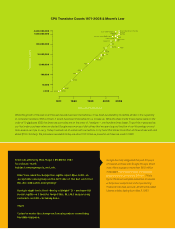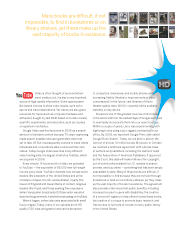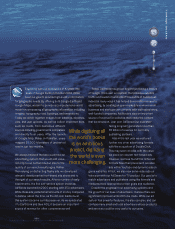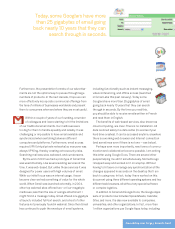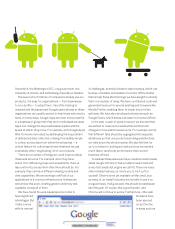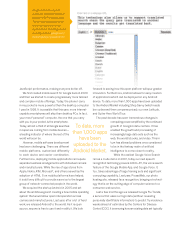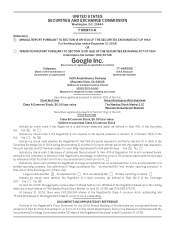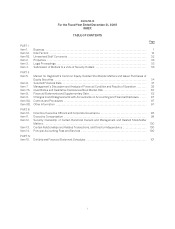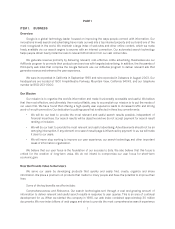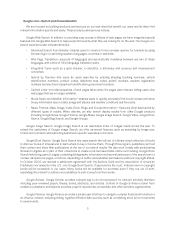Google 2008 Annual Report Download - page 9
Download and view the complete annual report
Please find page 9 of the 2008 Google annual report below. You can navigate through the pages in the report by either clicking on the pages listed below, or by using the keyword search tool below to find specific information within the annual report.
Furthermore, the presentation formats of our advertise-
ments are not the optimal way to peruse through large
numbers of products. In the next decade, I hope we can
more e ectively incorporate commercial o erings from
the tens of millions of businesses worldwide and present
them to consumers when and where they are most useful.
Within a couple of years of our founding, a number
of colleagues and I were starting to hit the limitations
of our traditional email clients. Our mailboxes were
too big for them to handle speedily and reliably. It was
challenging or impossible to have email available and
synchronized when switching between di erent
computers and platforms. Furthermore, email access
required VPN (virtual private networks) so everyone was
always VPN’ing, thereby creating extra security risks.
Searching mail was slow, awkward, and cumbersome.
By the end of 2001 we had a prototype of Gmail that
was used internally. Like several existing services at the
time, it was web-based. But unlike those services it was
designed for power users with high volumes of email.
While our initial focus was on internal usage, it soon
became clear we had something of value for the whole
world. When Gmail was launched externally, in 2004,
other top webmail sites o ered two- or four-megabyte
mailboxes, less than the size of a single attachment I
might fi nd in a message today. Gmail o ered one gigabyte
at launch, included full-text search, and a host of other
features not previously found in webmail. Since then Gmail
has continued to push the envelope of email systems,
including functionality such as instant messaging,
videoconferencing, and o ine access (launched
in Gmail Labs this past January). Today some
Googlers have more than 25 gigabytes of email
going back nearly 10 years that they can search
through in seconds. By the time you read this,
you should be able to receive emails written in French
and read them in English.
The benefi ts of web-based services, also known as
cloud computing, are clear. There is no installation. All
data is stored safely in a data center (no worries if your
hard drive crashes). It can be accessed anytime, anywhere
there is a working web browser and Internet connection
(and sometimes even if there is not one — see below).
Perhaps even more importantly, new forms of commu-
nication and collaboration become possible. I am writing
this letter using Google Docs. There are several other
people helping me edit it simultaneously. Moments ago
I stepped away and worked on it on a laptop. Without
having to hit save or manage any synchronization all the
changes appeared in seconds on the desktop that I am
back to using now. In fact, today I have worked on this
document using three di erent operating systems and two
di erent web browsers, all without any special software
or complex logistics.
In addition to Gmail and Google Docs, the Google Apps
suite of products now includes Spreadsheets, Calendar,
Sites, and more. It is also now available to companies,
universities, and other organizations. In fact, more than
1 million organizations use Google Apps today, including
Today, some Googlers have more
than 25 gigabytes of email going
back nearly 10 years that they can
search through in seconds.
Also editing now: Sergey, KarenW, AlexS

